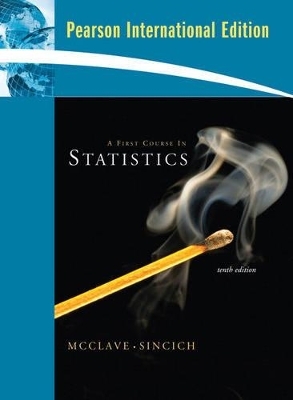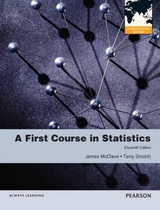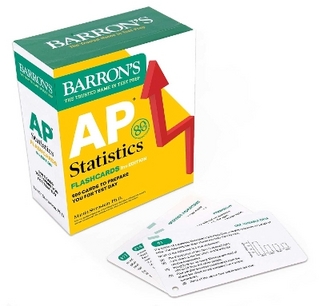
A First Course in Statistics
Pearson
978-0-13-236343-3 (ISBN)
- Titel erscheint in neuer Auflage
- Artikel merken
Datasets and other resources (where applicable) for this book are available here.
Dr. Jim McClave is currently President and CEO of Info Tech, Inc., a statistical consulting and software development firm with an international clientele. He is also currently an Adjunct Professor of Statistics at the University of Florida, where he was a full-time member of the faculty for twenty years. Terry Sincich obtained his PhD in Statistics from the University of Florida in 1980. He is an Associate Professor in the Information Systems & Decision Sciences Department at the University of South Florida in Tampa. Dr. Sincich is responsible for teaching basic statistics to all undergraduates, as well as advanced statistics to all doctoral candidates, in the College of Business Administration. He has published articles in such journals as the Journal of the American Statistical Association, International Journal of Forecasting, Academy of Management Journal, and the Auditing: A Journal of Practice & Theory. Dr. Sincich is a co-author of the texts Statistics, Statistics for Business & Economics, Statistics for Engineering & the Sciences, and A Second Course in Statistics: Regression Analysis.
1. Statistics, Data, and Statistical Thinking
1.1 The Science of Statistics
1.2 Types of Statistical Applications
1.3 Fundamental Elements of Statistics
1.4 Types of Data
1.5 Collecting Data
1.6 The Role of Statistics in Critical Thinking
Statistics in Action: USA Weekend Teen Surveys — Are Boys Really from Mars and Girls from Venus?
Using Technology: Creating and Listing Data in MINITAB
2. Methods for Describing Sets of Data
2.1 Describing Qualitative Data
2.2 Graphical Methods for Describing Quantitative Data
2.3 Summation Notation
2.4 Numerical Measures of Central Tendency
2.5 Numerical Measures of Variability
2.6 Interpreting the Standard Deviation
2.7 Numerical Measures of Relative Standing
2.8 Methods for Detecting Outliers (Optional)
2.9 Graphing Bivariate Relationships (Optional)
2.10 Distorting the Truth with Descriptive Techniques
Statistics In Action: The "Eye Cue" Test: Does Experience Improve Performance?
Using Technology: Describing Data in MINITAB
3. Probability (from McClave 11e–Chap 3)
3.1 Events, Sample Spaces, and Probability
3.2 Unions and Intersections
3.3 Complementary Events
3.4 The Additive Rule and Mutually Exclusive Events
3.5 Conditional Probability
3.6 The Multiplicative Rule and Independent Events
3.7 Random Sampling
3.8 Some Counting Rules (Optional)
Statistics In Action: Lotto Buster! — Can You Improve Your Chances of Winning the Lottery?
Using Technology: Generating a Random Sample in MINITAB
4. Random Variables and Probability Distributions
4.1 Two Types of Random Variables
4.2 Probability Distributions for Discrete Random Variables
4.3 The Binomial Distribution
4.4 Probability Distributions for Continuous Random Variables
4.5 The Normal Distribution
4.6 Descriptive Methods for Assessing Normality
4.7 Approximating a Binomial Distribution with a Normal Distribution (Optional)
4.8 Sampling Distributions
4.9 The Central Limit Theorem
Statistics in Action: Super Weapons Development — Is the Hit Ratio Optimized?
Using Technology: Binomial Probabilities, Normal Probabilities, and Normal Probability Plots in MINITAB
5. Inferences Based on a Single Sample: Estimation with Confidence Intervals
5.1 Identifying the Target Parameter
5.2 Large-Sample Confidence Interval for a Population Mean
5.3 Small-Sample Confidence Interval for a Population Mean
5.4 Large-Sample Confidence Interval for a Population Proportion
5.5 Determining the Sample Size
Statistics in Action: Speed — Can a High School Football Player Improve His Sprint Time?
Using Technology: Confidence Intervals in MINITAB
6. Inferences Based on a Single Sample: Tests of Hypothesis
6.1 The Elements of a Test of Hypothesis
6.2 Large-Sample Test of Hypothesis About a Population Mean
6.3 Observed Significance Levels: p-Values
6.4 Small-Sample Test of Hypothesis About a Population Mean
6.5 Large-Sample Test of Hypothesis About a Population Proportion
6.6 A Nonparametric Test about a Population Median (Optional)
Statistics in Action: Diary of a Kleenex User— How Many Tissues in a Box?
Using Technology: Tests of Hypothesis in MINITAB
7. Comparing Population Means
7.1 Identifying the Target Parameter
7.2 Comparing Two Population Means: Independent Sampling
7.3 Comparing Two Population Means: Paired Difference Experiments
7.4 Determining the Sample Size
7.5 A Nonparametric Test for Comparing Two Population: Independent Sampling (Optional)
7.6 A Nonparametric Test for Comparing Two Populations: Paired Difference Experiments (Optional)
7.7 Comparing Three or More Population Means: Analysis of Variance (Optional)
Statistics in Action: On the Trail of the Cockroach: Do Roaches Travel at Random?
Using Technology: Comparing Means in MINITAB
8. Comparing Population Proportions
8.1 Comparing Two Population Proportions: Independent Sampling
8.2 Determining the Sample Size
8.3 Contingency Table Analysis (Optional)
Statistics in Action: College Students and Alcohol — Is Drinking Frequency Related to Amount?
Using Technology: Chi-Square Analyses in MINITAB
9. Simple Linear Regression
9.1 Probabilistic Models
9.2 Fitting the Model: The Least Squares Approach
9.3 Model Assumptions
9.4 Assessing the Utility of the Model: Making Inferences About the Slope β1
9.5 The Coefficients of Correlation and Determination
9.6 Using the Model for Estimation and Prediction
9.7 A Complete Example
9.8 A Nonparametric Test for Correlation (Optional)
Statistics in Action: Can "Dowsers" Really Detect Water?
Using Technology: Simple Linear Regression in MINITAB
Appendix A: Tables
Table I Random Numbers
Table II Binomial Probabilities
Table III Normal Curve Areas
Table IV Critical Values of t
Table V Critical Values of TL and TU for the Wilcoxon Rank Sum Test: Independent Samples
Table VI Critical Values of T0 in the Wilcoxon Paired Difference Signed Rank Test
Table VII Percentage Points of the F Distribution, α=.10
Table VIII Percentage Points of the F Distribution, α=.05
Table IX Percentage Points of the F Distribution, α=.025
Table X Percentage Points of the F Distribution, α=.01
Table XI Critical Values of χ2
Table XII Critical Values of Spearman's Rank Correlation Coefficient
Short Answers to Selected Odd-Numbered Exercises
Index
| Erscheint lt. Verlag | 19.2.2008 |
|---|---|
| Sprache | englisch |
| Maße | 275 x 215 mm |
| Gewicht | 1254 g |
| Themenwelt | Mathematik / Informatik ► Mathematik ► Statistik |
| ISBN-10 | 0-13-236343-7 / 0132363437 |
| ISBN-13 | 978-0-13-236343-3 / 9780132363433 |
| Zustand | Neuware |
| Haben Sie eine Frage zum Produkt? |
aus dem Bereich



